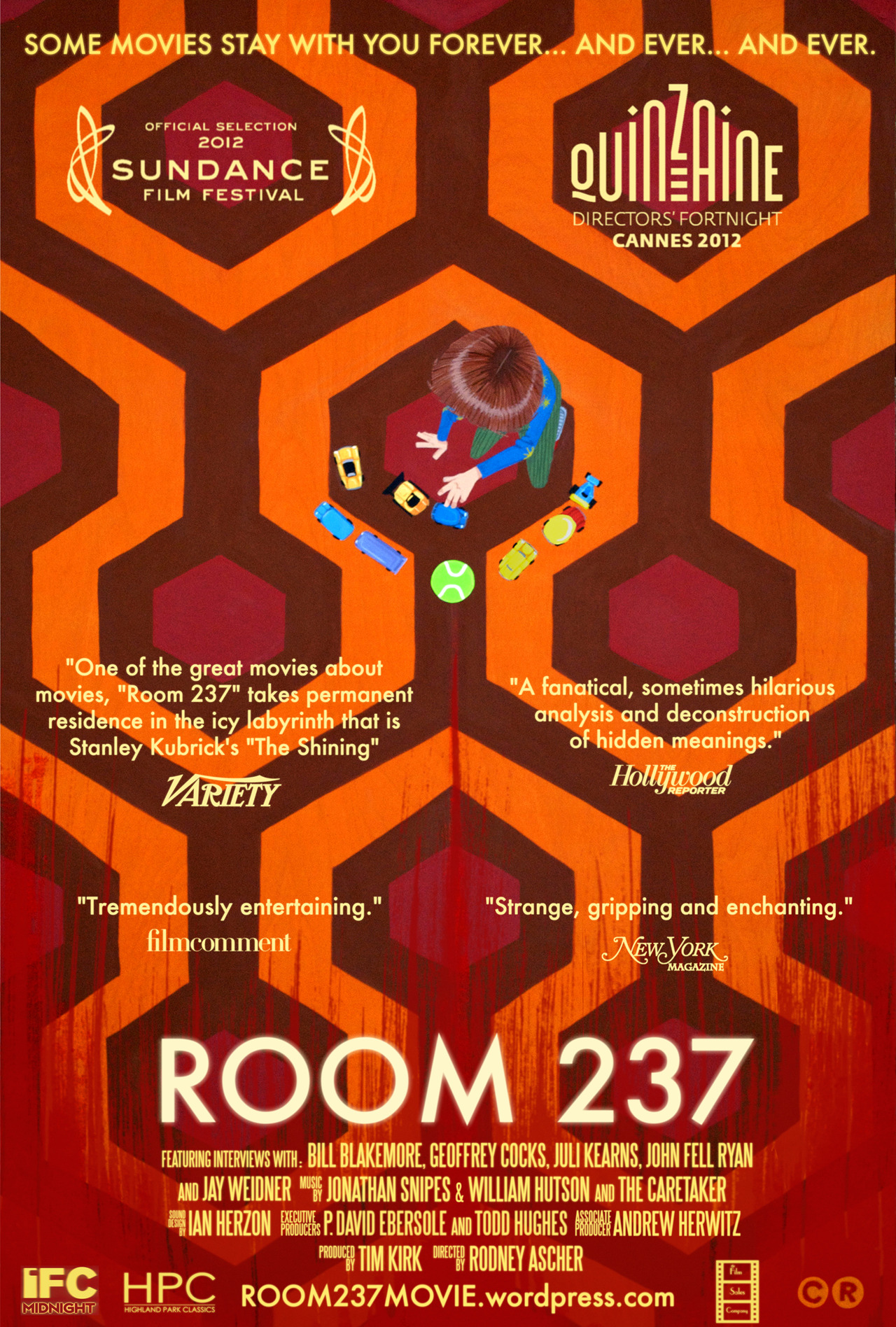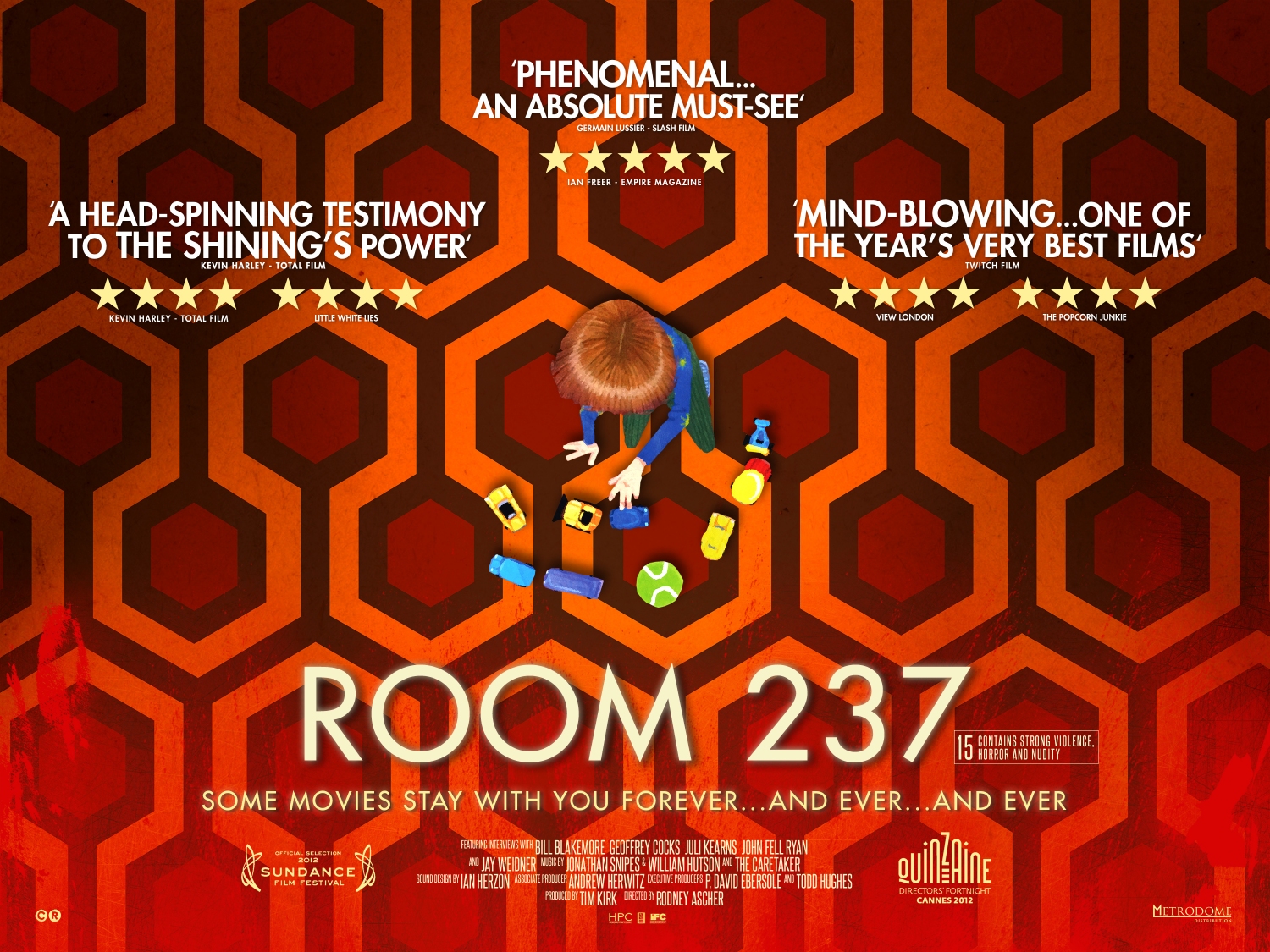March 7, 2013
 Room 237 is a documentary that presents five people who have spent a great deal of time scrutinizing every frame of Stanley Kubrick’s adaptation of The Shining for hidden meaning.
Room 237 is a documentary that presents five people who have spent a great deal of time scrutinizing every frame of Stanley Kubrick’s adaptation of The Shining for hidden meaning.
And oh what hidden meanings they’ve found. Bill Blakemore—who, based on his credentials as a foreign and domestic correspondent for ABC, might seem otherwise credible—thinks the film is an allegory about the genocide of the American Indians. The Overlook is, after all, built on an Indian burial ground. He believes that a can of Calumet baking powder with an Indian head on the label supports his theory and the way the can is turned in different scenes indicates the characters’ veracity.
Historian Geoffrey Cocks, who has published books about Nazi Germany, uses the proliferation of the number 42 and the fact that Jack’s typewriter is German as evidence that the movie is about the Holocaust, which began in earnest in 1942. The number is on the sleeve of Danny’s sweater. Danny and Wendy watch The Summer of ‘42. It’s on a license plate. There are 42 cars in the hotel parking lot, among other less obvious occurrences. And, of course, 2 x 3 x 7 = 42.
At least those two hypotheses are rooted in historical fact, although neither man explains what the film is saying about genocide. “Hermetic scholar” Jay Weidner believes that The Shining is Kubrick’s confession that he faked the footage of the Apollo 11 moon landing. He doesn’t deny that we went to the moon—just that the shots from the surface were created in a studio. (This theory is convincingly debunked in this video, which explains that we didn’t have the technology in 1969 to fake the films.)
Weidner goes on to point out that in King’s book the Torrance’s VW was red, whereas in the film it’s yellow. However, Dick Hallorann sees a red VW crushed beneath a transport on his way back to the Overlook, which is a big “F.U.” to King. “This is my vehicle and I have wrecked your vehicle,” Weidner believes Kubrick is saying. Maybe so—who knows? However, he goes off the rails again when he claims that every time Kubrick deviates from the novel, he veers into moonshot faking territory. At times he sounds truly paranoid. “They’re watching me,” he claims. “I’m sure to be audited after this comes out.”
Juli Kearns says that a poster in the game room can’t contain the image of a skier because Ullman stated that there is no skiing near the Overlook. No, it’s actually a Minotaur. Why? Because there’s a maze outside the hotel, of course. She makes much of the impossible window in Ullman’s office without attempting any analysis. (Rob Ager’s breakdown of the Overlook’s spatial impossibilities is much more fascinating and illuminating.)
The speakers are never shown, which makes it difficult to identify them at times. No one interrogates or challenges them. They speak in declarative sentences (“Kubrick was a Freudian”) without backing up such statements. Every comment is illustrated with a film clip, sometimes to hilarious effect. When Blakemore talks about leaning forward in his seat while watching The Shining for the first time, the movie shows a clip of a random man (not Blakemore) leaning forward in his seat.

To these five people, Kubrick is infallible. He was a preternaturally observant child. He had an IQ of 200. He was a bored genius who thought about the implications of everything that exists. There are no mistakes. Every supposed continuity error (a character’s pants change between wide shots and close-ups, for example) is really a “confirmer” of a particular theory.
Every now and then, they point out something that might be a real symbol. The pattern in the carpet in Room 237 may well depict the sex act. However, some of the contributors distort reality to fit a theory. Weidner says that Kubrick changed the room number from 217 to 237 because the distance between the earth and the moon is 237,000 miles. It’s actually closer to 239,000, but what’s a couple of thousand miles to a conspiracy theorist? He goes on to say that the only two words that can be spelled from the capital letters on the keytag that says ROOM N° 237 are “room” and “moon.” A more generous person might refrain from pointing out a third word: moron!
One of the most fascinating sections analyzes a character most people won’t even remember: Bill Watson. He’s the taciturn summer caretaker who joins Ullman and Jack for the interview. Blakemore believes his skin tone is “a little dark,” so his dour, resentful demeanor represents the condition of Indians in the dominant arrogant culture. Weidner thinks that Watson is a CIA or NSA agent, silently watching everything. Ullman, with his JFK hair, represents the American government. When all you have is a hammer, every problem looks like a nail.
The strangest analysis—and these people set the bar pretty high—comes from John Fell Ryan, a nervous-sounding man who keyed in on a line from another obsessive—who was invited to participate in Room 237 but declined—who said that The Shining is meant to be watched both backwards and forwards. This led Ryan to project the film on top of itself, one copy running forward and the other in reverse. He points out a number of “interesting” superpositions without drawing any conclusions. When he says, “I could go on for a long time about his,” you get the feeling that he could indeed.
Each contributor confesses that he or she has watched the film dozens—if not hundreds—of times. Ryan speculates that Kubrick’s hidden messages are a way of trapping people like him. He feels as ensnared by the Overlook as Jack and his family. One interviewee wonders aloud if he’s only seeing what he wants to see, but then another “confirming” clue emerges and he’s off again. Some acknowledge that Kubrick may have had only some or none of these interpretations in mind when he made the film. If you don’t buy into the theory that he had a secret agenda in making The Shining, there’s always the mantra of post-modern criticism: these meanings are there regardless of whether or not the work’s creator is conscious of them.
It’s funny, the attention these people give to esoteric details—like chairs that move between cuts—while ignoring others. For example, what should one make of the almost subliminal bloody handprint seen on the rear of a woman in the ballroom? None of the five even mention it. However, after listening to these far-fetched and outlandish theories for nearly two hours, one comes away wondering: My god! What if they’re right?
Room 237 will be in select theaters and on IFC Midnight’s video-on-demand service on March 29. Dust off your tinfoil hats.
